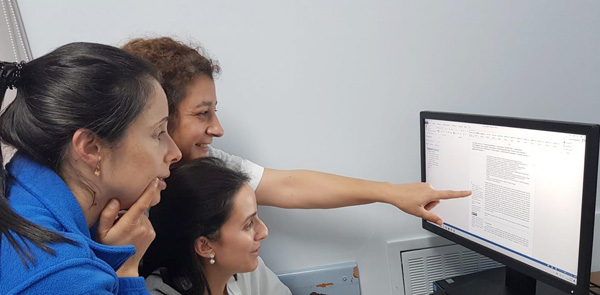Strengthening bridges of evidence: GRiP as a collaborative communication strategy
Authors: Daniela Cardoso, Ana Filipa Cardoso and António Manuel Fernandes
Health Sciences Research Unit: Nursing; Nursing School of the University of Coimbra
JBI Portugal Centre for Evidence-Based Practice
Introduction
This year's World Evidence-Based Healthcare (EBHC) Day campaign focuses on ‘Collaborative Knowledge Communication.’ Coincidentally, the JBI Model of EBHC has four underlying principles, two of which are Communication and Collaboration. JBI's approach to evidence implementation, which complements and operationalises the JBI Model for EBHC, also has the ‘facilitation of change’ as a key component. Moreover, it proposes the Getting Research into Practice (GRiP) method to close the gap between evidence and practice. With this in mind, we would like to share our experiences and insights about how GRiP can be a Collaborative Knowledge Communication strategy that helps us to exchange knowledge and, consequently, facilitate the decision-making process for evidence-based practice.
Getting Research into Practice (GRiP) in JBI's approach to evidence implementation
The JBI approach to evidence implementation follows seven phases to ‘get research into practice’. Phases 1, 2 and 3 focus on planning how to put the evidence into practice, starting by the identification of the practice area that we want to change, followed by engagement of key stakeholders who will act as change agents, and then assessing the context and its readiness to change. Phases 4, 5, 6 and 7 are the ‘doing’ phases: Phase 4 reviews current practice against evidence-based audit criteria, Phase 5 implements the changes to practice, Phase 6 re-assesses practice after the new changes and Phase 7 plans for the sustainability of the changes.
Although all phases require good communication and collaboration, we would like to focus on the ‘doing’ implementation phases, particularly Phase 5, which involves applying the GRiP approach.
In this phase, the teams are invited to:
1. analyse the results of the baseline audit (which compares current clinical practices against the best available evidence);
2. identify the barriers that are preventing the use of the best evidence and identify the facilitators to the use of best evidence;
3. design and implement strategies that promote change in practices, considering the existing barriers and facilitators.
The GRiP method is key to facilitating change in healthcare contexts, and relies on a collaborative approach for promoting the change. Therefore, GRiP can be viewed as a collaborative communication strategy, as it promotes the sharing of all forms of knowledge (explicit, implicit, tacit, and indigenous) as well as ideas and expertise to transform healthcare settings and make real changes.
GRiP as a collaborative knowledge communication strategy: Experiences from Portugal
Over the past 5 years, we had the pleasure to work with clinical teams from different healthcare contexts to improve the use of the best available evidence, using JBI's approach to evidence implementation.
As facilitators, we start the GRiP phase by presenting the results of the baseline audit (i.e. comparing current practices with the best evidence). We do this preferably face-to-face, in more than on session, to reach all stakeholders. We then work in small groups to discuss the results of the baseline audit in order to identify barriers to best practices, facilitators and strategies to overcome the barriers. Next, each group presents their ideas, promoting discussion to reach a final plan about what strategies need to be implemented.
Through our work as facilitators, we have realised that the involvement of the entire care team at the point of care in the GRiP phase is crucial. This involvement greatly facilitates the communication of evidence to all of those involved and encourages knowledge-sharing and willingness to change practices.
Moreover, we have found that GRiP helps to raise awareness about the best evidence and the need for change. It al; also promotes collaborative communication that facilitates the creation of a shared commitment to achieving change.

Testimonials from Portuguese nurses
Several testimonials from nurses involved in initiatives to implement the best available evidence reinforce the idea that GRiP is a collaborative knowledge communication strategy:
‘The GRiP method is a valuable strategy for communicating evidence, as it allows the dissemination of scientific knowledge in a structured, understandable and applicable way in the context of care. Simply disseminating research results is not enough to bring about change in practices; it is necessary to translate them into clear messages that are adapted to the reality of the services. In this sense, GRIP defines steps that not only favour the translation of evidence into concrete proposals, but also encourage team participation in identifying barriers and facilitators. Its greatest contribution is in promoting an inclusive communication process that generates involvement, dialogue, and shared responsibility, making it a fundamental tool for the sustainability of good practices and the continuous improvement of healthcare.’ Liliana Pita, Nurse
‘Nurses, as professionals with their own body of knowledge, base their autonomous decision-making on the best available evidence. The use of GRiP allows for a reflective and constructive comparison of current care with scientific evidence, while simultaneously allowing us to identify the real needs of the team and to structure new care. In this way, GRiP is an essential resource for communicating and integrating evidence into nursing practice.’ Maribel Pinto, Nurse
‘The GRiP phase is the practical and dynamic phase of the implementation project. It is the most operational because:
1. It transforms evidence into practical language, enabling it to be understood by nurses.
2. It facilitates clear and structured communication, allowing all team members to understand the ‘why’ and ‘how’ of the change, with each person knowing their responsibilities and the impact on the process.
3. It acts as a tool for negotiation and for encouragement.’ Pedro Henriques, Nurse
‘As a nurse, I consider GRiP an extremely valuable method, as it involves the entire multidisciplinary team and ensures that evidence is not only discussed but also applied in a practical, understandable and sustainable way. GRiP allows us to translate scientific language into practical language, transforming guidelines into clear procedures that can be applied in everyday clinical practice; adapt evidence to the local context; use accessible communication formats; foster interprofessional dialogue, creating space for everyone to question, add perspectives, and take ownership of the evidence; and give concrete examples that link research to real situations, making it more relevant and meaningful for professionals, users, and families.’ Lisa Nunes, Nurse
GRiP in action
Across Portugal, GRiP has been applied in diverse settings, from long-term care units to vascular surgery wards, showcasing how collaborative communication through GRiP transforms evidence into practice.
For example, in one long-term care unit, nurses used GRiP to identify poor handover communication as a key barrier to patient safety. Through facilitated workshops and focus groups, the team improved the use of a structured communication tool (ISBAR) in their context and introduced communication and conflict-management training, raising structured handover compliance from 44% to 91%.
In another project, vascular nurses used GRiP to strengthen post-discharge telephone follow-up for people with chronic vascular disease. By analysing baseline audit data and discussing barriers such as lack of training and inconsistent documentation, the team implemented targeted education, standardised procedures and patient education resources. Within months, compliance with best practice for telephone follow-up rose from 0% to 60%.
Together, these examples demonstrate that GRiP is far more than a planning tool—it is a process of dialogue, co-creation and shared learning. By embedding communication and collaboration, GRiP empowers health professionals to turn evidence into action that is contextually relevant, measurable and sustainable.
Based on these testimonials and on our experience, we firmly believe that GRiP is a method that promotes the active involvement of all the stakeholders in the sharing of information, ideas and experiences to facilitate problem-solving and find innovative solutions using the best available evidence. Therefore, we believe that GRiP encourages collaborative knowledge communication to promote the use of evidence in clinical settings.
Key take-home messages
Our reflections on GRiP as a collaborative communication strategy leads us to conclude that:
- GRiP is a collaborative communication strategy that facilitates knowledge translation to clinical practice.
- GRiP is an inclusive communication process that promotes the sharing of all forms of knowledge, ideas and expertise, as well as involvement and dialogue with all stakeholders to transform healthcare settings and make real change.
- GRiP is an inclusive negotiation strategy that helps to solve real problems to inform clinical decision-making and improve healthcare practices and outcomes.
References
Jordan, Z., Pilla, B., Porritt, K., Munn, Z., Aromataris, E., & Lockwood, C. (2023). Turning the flywheel: mobilizing the JBI Model of Evidence-Based Healthcare. JBI Evidence Implementation, 21(1), 96-100. https://doi.org/10.1097/XEB.0000000000000342
Jordan, Z., Lockwood, C., Munn, Z., & Aromataris, E. (2019). The updated Joanna Briggs Institute Model of Evidence-Based Healthcare. JBI Evidence Implementation, 17(1), 58-71. https://doi.org/10.1097/XEB.0000000000000155
Porritt, K., McArthur, A., Lockwood, C., & Munn, Z. (2023). JBI's approach to evidence implementation: a 7-phase process model to support and guide getting evidence into practice. JBI Evidence Implementation, 21(1), 3-13. https://doi.org/10.1097/XEB.0000000000000361
To link to this article - DOI: https://doi.org/10.70253/BUSD9641
Links to additional resources
Link to JBI Manual for Evidence Implementation: https://jbi-global-wiki.refined.site/space/JHEI
Links to evidence implementation reports:
https://doi.org/10.1097/XEB.0000000000000328
https://doi.org/10.1097/XEB.0000000000000380
https://doi.org/10.1097/XEB.0000000000000347
https://doi.org/10.1097/XEB.0000000000000487
https://doi.org/10.1097/XEB.0000000000000482
Disclaimer
The views expressed in this World EBHC Day Blog, as well as any errors or omissions, are the sole responsibility of the author and do not represent the views of the World EBHC Day Steering Committee, Official Partners or Sponsors; nor does it imply endorsement by the aforementioned parties.
